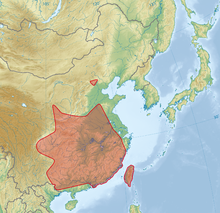Chinese noctule
| Chinese noctule | ||||||||||||
|---|---|---|---|---|---|---|---|---|---|---|---|---|
| Systematics | ||||||||||||
|
||||||||||||
| Scientific name | ||||||||||||
| Nyctalus plancyi | ||||||||||||
| Gerbe , 1880 |
The Chinese noctule bat ( Nyctalus plancyi ) is a bat species from the genus of the noctule bat within the smooth-nosed bat (Vespertilionidae). It is endemic to the People's Republic of China with a comparatively large distribution area in the southeast of the country and on Taiwan .
features
Nyctalus aviator is a relatively small species compared to other noctule swifts , with a head and trunk length of 6.5 to 7.5 centimeters with a tail 3.6 to 5.2 centimeters in length. The forearm reaches a length of 4.7 to 5.0 centimeters, the hind foot is 1.0 to 1.1 centimeters long and the ear 1.5 to 1.8 centimeters. The fur is brown and darker than that of the great noctule ; the bases of the hair are colored red-brown and the tips dark brown. The belly side is slightly lighter than the back. The hair also extends to parts of the flight skin and the tail skin.
Characteristic features of the species relate primarily to the structure of the skull and the teeth, for example the upper outer incisor is very flat.
distribution
The Chinese noctule bat is endemic to the People's Republic of China with a comparatively large distribution area in the southeast of the country and on Taiwan . It occurs in two subspecies, of which N. p. plancyi in Beijing , Shandong , Henan , Shaanxi , Gansu , Liaoning and Jilin provinces, and N. p. velutinus occurs in Fujian , Anhui , Jiangsu , Zhejiang , Jiangxi , Guangdong , Guangxi , Hunan , Hubei , Guizhou , Yunnan , Sichuan and Hebei provinces , as well as in Hong Kong and Taiwan .
Way of life
The Chinese noctule bat is nocturnal and, like other species of the genus, feeds primarily on insects. In addition to caves, old trees and crevices, old temples and roofs were identified as resting places of the species, from which it starts its prey flights.
Wintering with the pairings begins in early to mid November. The ovulation falls in March, wherein the females store the male semen and delayed so that the fertilization bring. The gestation period is 50 to 60 days and two young are usually born in June.
Systematics
|
Phylogenetic system of the genus Nyctalus
|
The Chinese noctule bat is one of the currently eight species within the noctule bat ( Nyctalus ), of which the great noctule bat ( Nyctalus noctula ) and Nyctalus aviator also occur in its range . In some cases, Nyctalus aviator was regarded as a subspecies of the noctule bat, in some cases the two subspecies were also considered to be separate species.
According to a study by Salgueiro et al. In 2007, the Chinese noctule was the most basal species and thus the sister species of the remaining noctule species. The remaining species are divided into two groups, one of which is the great noctule ( Nyctalus noctula ), the giant noctule ( Nyctalus lasiopterus ) and Nyctalus aviator and the other from the small noctule ( Nyctalus leisleri ) and in the Azores endemic Azores noctule ( Nyctalus azoreum ) is formed. The common noctule bat ( Nyctalus montanus ), which was also previously considered a subspecies of the noctule bat , and Nyctalus furvus were not considered in this study.
Hazard and protection
The species is listed as not endangered ( least concern ) by the IUCN due to its large distribution area and the assumed large population . A decline or potential threats to the continued existence of the company are not known.
The species is also listed as not endangered in China's Red List of Endangered Species.
supporting documents
- ↑ a b c d e Don E. Wilson Chinese Noctule. In: Andrew T. Smith , Yan Xie: A Guide to the Mammals of China. Princeton University Press, 2008; P. 362. ISBN 978-0-691-09984-2 .
- ↑ a b c d Nyctalus plancyi in the Red List of Threatened Species of the IUCN 2012.1. Listed by: AT Smith, CH Johnston, CH, 2008. Retrieved September 19, 2012.
- ↑ a b c P. Salgueiro, M. Ruedi, MM Coelho, JM Palmeirim: Genetic divergence and phylogeography in the genus Nyctalus (Mammalia, Chiroptera): implications for population history of the insular bat Nyctalus azoreum. Genetica 130 (2), 2007: pp. 169-181.
literature
- Don E. Wilson : Chinese Noctule. In: Andrew T. Smith , Yan Xie: A Guide to the Mammals of China. Princeton University Press, 2008; P. 362. ISBN 978-0-691-09984-2 .
Web links
- Nyctalus plancyi inthe IUCN Red List of Threatened Species 2012.1. Listed by: AT Smith, CH Johnston, CH, 2008. Retrieved September 19, 2012.
- Species portrait of the Chinese noctule with pictures
